Правила цитадели: Правила игры Цитадели | Купить настольную игру в магазинах Мосигра
Правила игры Цитадели — citadeli.ru
RulebookIn Citadels, each player leads a city and seeks to increase its prosperity by building new city districts. The game ends after one player has built his eight district, after which a winner is determined by points. Building the most impressive city however, is not an easy task. Only by influencing nobles, merchants, and other powerful characters of the realm will you achieve success. COMPONENTS Citadels includes district cards, character cards, reference cards, gold counters, and the wooden crown piece. District Cards These cards represent the various districts that you can add to your city. Each district card has a cost, represented by a number of gold coins along the card’s left edge. In order to put a district card into play, you must pay its cost in gold. Each district card also exhibits a color on its bottom left hand corner, which tells you what type of district it is: Color Type Yellow Noble (provides income to the King) Blue Religious (provides income to the Bishop) Green Trade (provides income to the Merchant) Red Military (provides income to the Warlord) Purple Special (provides the special benefits described on the card itself) 2 Fourteen of the purple district cards are bonus cards marked by a white star.Before you play your first game, remove these cards. Rules for how to use the bonus district cards are found later. Character Cards These cards represent the characters that players will seek to influence during every game round. There are 8 basic characters in Citadels, but in this edition you will also find 10 additional bonus character cards marked by a white star. These bonus characters are not used in the basic game. Before you play your first game, remove these cards. As with the district bonus cards, we will teach you how to use them later in this rules set. In addition to a special ability, each character card has a rank number between 1 to 9. This is printed on the upper left hand side of the card. Reference Cards Each player should be given one of these cards at the beginning of the game. They are useful for gameplay, especially during your first few games. Gold Counters These represent the gold needed to build district cards. They should be placed on the table in a central “Bank” at the beginning of the game. 3 The Wooden Crown counter The player who has the Crown is the first player to choose a character card during the next round. The Crown switches owners whenever another player uses the ability of the “King” character. SETTING UP THE BASIC GAME To prepare Citadels for play, follow these steps: 1. Remove the bonus character and district cards (marked by a white star). 2. Shuffle the eight remaining character cards together into one deck. This is called the Character Deck. 3. Shuffle the remaining district cards together into one deck. This is called the District Deck. 4. Each player is then dealt four random district cards from the District Deck. 5. Each player receives two gold from the bank. 6. The oldest player receives the Crown. PLAYING THE GAME Playing the game with 4-6 players is described below.
If you are playing with 2, 3, or 7 players, see the special rules later in this rules set. Citadels is played over a series of rounds. There are four steps to each round. Step One: Remove Characters First draw one random card from the Character Deck and set it facedown in the center of the table without looking at it. This card will not be used this round. 4 Then draw a second set of cards from the Character Deck and set them faceup in the middle of the table (the number of such faceup cards depends on the number of players, see the table below). These faceup cards will not be used this round. Special rule: If you draw the “King” character to be faceup, immediately replace it with another random card from the Character Deck, then shuffle the King back into the Character Deck. Step Two: Choose Characters The player who currently possesses the Crown now takes the Character Deck, looks at the cards, and secretly chooses a character from here. He then passes the remaining character cards to the player on his left, who also secretly chooses a card and passes the remaining cards to the left, etc. This continues until each player has chosen one card from the Character Deck. After the last player has chosen, the single remaining unchosen card is placed facedown in the center of the table. Step Three: Player Turns Once all players have chosen a character card, the player who has the Crown now calls out the name of each character one-at-a-time in the order of numerical rank. In this way, he will first call out the “Assassin” (#1), then the “Thief” (#2), etc. If no 4 2 5 1 6-7 0 Number of Players Number of faceup cards FACE UP CARDS FOR 4-7 PLAYERS 5 player reveals that a character when called, simply proceed to call out the next character in rank order. When the name of your character card is called, you must reveal your character card, place it faceup in front of you, and take your turn.
When your turn is over, the player with the Crown calls the name of the next character card. In this manner, play proceeds to every character in order of their rank number, giving all players one turn (unless assassinated, of course). On Your Turn On your turn, you must first take an action, after which you may build a district card. 1) Take an Action: At the beginning of your turn, you must do one of the following: • Take two gold from the bank, • Or, draw two district cards from the District Deck, choose one card to put in your hand, and place the other card on the bottom of the District deck. 2) Build a District Card: After you have done one of the two things above, you may build one district card in your city (that is, play it from your hand onto the table in front of you). In order to do so, you must pay the cost of the district, in gold, to the bank. You may choose not to build a district card if you wish. The gold cost of building a district card is equal to the number of gold coins printed on the upper left hand side of the card. 6 You may not build a district so that you have two identical districts (two “Castle” cards, two “Market” cards, etc.) in your city. The Special Abilities of Characters Each character has a special ability, also called its power. You may use your character’s power once during your turn. The powers of each character are summarized on their respective cards and explained in detail at the end of these rules. Be sure to familiarize yourself with the detailed powers before playing your first game. Step Four: End of Round After all the characters have been called, each player returns his character card to the Character Deck, which is shuffled, and a new round begins. GAME END When a player builds his eighth district, the game ends after the current round is completed. At the end of the game, each player receives points for all of the following: • A player receives a number of points equal to the total combined gold cost of all the district cards in his city at the end of the game • If a player has at least one district in each of the five colors, he receives 3 points • If a player was the first player to build eight districts, he receives 4 points • All other players that have managed to build eight districts at the end of the game receive 2 points The winner of the game is the player with the most points. 7 OTHER RULES Two- or Three-Player Games In a two- or three-player game, all players play with two characters each. The game is played normally, except that each player will have two turns during each round (one turn for each character). Players do not have to separate their gold or their districts between their characters, as they still only have one city.
A player can, for example, keep the money earned by his first character to build an expensive district with his second character. If you are playing with two or three players, the rules for preparing the character deck and choosing character cards is changed in the following ways: Two-Player Game 1. The player who has the Crown (Player A) shuffles the Character Deck and places a random character card facedown in the center of the table. He then secretly selects a character card from the remaining cards and passes the remaining six character cards to the other player (Player B). 2. Player B selects one card from the Character Deck for himself, and then chooses and places another card facedown in the center of the table. He then passes the remaining four cards to Player A. 3. Player A selects one of the remaining four cards for himself, after which he chooses and places another of the cards facedown in the center of the table. He then passes the remaining two cards to Player B. 8 4. Player B takes one of the remaining cards, placing the last card facedown in the center of the table. The Three-Player Game The player with the Crown takes the Character Deck, places a random card facedown in the middle of the table, and then secretly chooses a character for himself. He then passes the remaining character cards to the player on his left, who also chooses a card, and then passes the remaining cards to the left, etc. This continues until each player has chosen two cards from the Character Deck. The last player will select one of the two remaining cards, and place the last card facedown in the center of the table. The Seven-Player Game A seven player game of Citadels plays much like the normal game, with one exception: During the “Choose Characters” step of a sevenplayer game, when the seventh player is handed the last character card from the sixth player, he secretly looks at the facedown card on the table.
He will then choose one of these two cards, placing the other card facedown in the center of the table, allowing no other player to look at it. BONUS CARDS This edition of Citadels includes 10 extra bonus Character cards (each marked with a white star), and 14 extra purple district cards (also marked with a white star). You can add these bonus cards to your Citadels game for more fun and variety. 9 Bonus Characters The bonus Character cards can be used in the following ways: Before the game begins, players may agree to remove one or two of the original eight character cards and replace them with the bonus characters of the same rank numbers. For example, you may agree to remove the Merchant (#6) and replace him with the Alchemist (#6). If you decide to use one of the rank 9 characters in a four- to seven-player game, you must place a number of random faceup at the beginning of each round, as detailed in the table below. When using a rank 9 character card, you can play Citadels with eight players. When playing with eight players, simply use the rule for the sevenplayer game in which the last player may chose between the remaining character and the facedown character in the middle of the table. 4 3 5 2 6 1 7 0 Number of Players Number of faceup cards FACEUP CARDS FOR 4-7 PLAYERS WHEN PLAYING WITH 9 CHARACTERS 10 The Bonus District Cards Before the game begins, players may agree to add 2-3 additional purple district cards to the District Deck from the 14 available bonus district cards. If players wish to use more than 2-3 of the bonus district cards, they should remove one existing purple district card for each additional bonus district card used. Shorter Game If players agree, the game can be made shorter by playing to seven districts instead of eight.
THE CHARACTERS Every character in Citadels has a unique special power. You may (it is not mandatory to use the special power) use your character’s power once at any point during your turn. Each character’s power is summarized on its card, and detailed below: Note: Characters who receive income for certain types of districts in their cities (the King, Emperor, Bishop, Abbot, Merchant, Diplomat, and Warlord) may use their power to receive this gold at any point in their turn. Thus you may choose to receive your income either before building new districts (if you need the gold in order to build the districts), or after building new districts (to gain income from the newly built district). You cannot, however, do both. 11 12 1) Assassin Announce the title of another character that you wish to murder. The player who has the murdered character must say nothing, and must remain silent when the murdered character is called upon to take his turn.
The murdered character misses his entire turn. 2) Thief Announce the title of a character from whom you wish to steal. When the player who has that character is called upon to take his turn, you first take all of his gold. You may not steal from the Assassin or the Assassin’s target. 3) Magician At any time during your turn, you may do one of the following two things: • Exchange your entire hand of cards (not the cards in your city) with the hand of another player (this applies even if you have no cards in your hand, in which case you simply take the other player’s cards). • Place any number of cards from your hand facedown at the bottom of the District Deck, then draw an equal number of cards from the top of the District Deck. 13 4) King You receive one gold for each noble (yellow) district in your city. When the King is called, you immediately receive the Crown.
You will now call the characters, and you will be the first player to choose your character during the next round. If there is no King during the next round, you keep the Crown. If you are murdered, you skip your turn like any other character. Nevertheless, after the last player has played his turn, when it becomes known that you had the murdered King’s character card, you take the Crown (as the king's heir). 5) Bishop You receive one gold for each religious (blue) district in your city. Your districts may not be destroyed by the Warlord. 6) Merchant You receive one gold for each trade (green) district in your city. After you take an action, you receive one additional gold. 14 7) Architect After you take an action, you draw two additional district cards and put both in your hand. You may build up to three districts during your turn. 8) Warlord You receive one gold for each military (red) district in your city.
At the end of your turn, you may destroy one district of your choice by paying a number of gold equal to one less than the cost of the district. Thus, you may destroy a cost 1 district for free, a cost 2 district for 1 gold, or a cost 5 district for 4 gold, etc. You may destroy one of your own districts. You may not, however, destroy a district in a city that is already completed by having eight districts. Credits Design: Bruno Faidutti Illustration: Julien Delval, Florence Magnin, Jean-Louis Mourier, Jesper Ejsing, Bjarne Hansen Graphic Design: Cyrille Daujean, Brian Schomburg, Scott Nicely, Richard Spicer, Christian T. Petersen Editing & Rules: Darrell Hardy, Christian T. Petersen Citadels and Citadels: Dark City Expansion are a trademark of Fantasy Flight Publishing, Inc. Copyright ©2006 Fantasy Flight Publishing, Inc. All rights reserved. No part of this product may be reproduced without specific permission from the publisher.
15 BONUS CHARACTERS 1) Witch After you take an action, announce the title of another character that you wish to bewitch, then immediately end your turn. When the bewitched character is called upon, its player must show his character card, take an action, and then immediately end his turn. You now resume this player’s turn as if you were playing the bewitched character, using all that character’s powers (including the gold bonus of the Merchant or the two card bonus of the Architect) in your city. If the King is bewitched, the King player still receives the Crown counter. If the bewitched character is not in play, you do not resume your turn. The Thief cannot steal from the Witch or the bewitched character. 2) Tax Collector After another player has built one or more districts in his city, that player must, at the end of his turn, give you one gold (if he has any gold left).
If the Assassin or the Witch has already built a district card, their players must pay you one gold as you reveal that you have the Tax Collector. 16 3) Wizard You may look at another player’s hand of cards and take one card. You may then either put this card into your hand, or pay to build it in your city. If you build it in your city, it does not count towards the one district building limit, which means you can build another district as well. During this turn, you may build district cards identical to another district already in your city. 4) Emperor You receive one gold for each noble (yellow) district in your city. When the Emperor is called, you immediately must take the Crown from the player who has it and give it to a different player (but not yourself). The player who receives the Crown must give you either one gold or one district card from his hand. If the player has neither a gold nor a card, he does not have to give you anything.
(Note that, like the King, the Emperor may not be in the faceup discarded character cards.) 5) Abbot You receive one gold for each religious (blue) district in your city. The player who has the most gold must give you one gold. If there is a tie for the player with the most gold, or if you have the most gold, then you do not receive the gold. 17 6) Alchemist At the end of your turn, you receive back all the gold you spent to build district cards this turn, but not the gold you spent for other reasons (paying the Tax Collector, for example). You cannot spend more gold than you have during your turn. 7) Navigator After taking your action, you may either receive an additional four gold or draw an additional four cards. You may not build any district cards. 8) Diplomat You receive one gold for each military (red) district in your city. At the end of your turn, you may take a district from another player’s city in exchange for a district in your city.
If the district you take has a higher cost than the district you give, you must pay the difference in gold to the player with whom you make the exchange. (The Great Wall affects this cost.) You may not take the Keep district, or any districts in the Bishop’s city. Note: If you are using the Diplomat in your game, you must remove the Cemetery from the deck, as it will not be used. 18 9) Queen You receive three gold if you are sitting next to the King (or the Emperor). If the King has been murdered, but was sitting beside you, you receive three gold when this becomes known (that is, immediately after your turn). Note: Do not use the Queen in a game with fewer than five players. 9) Artist You may “beautify” one or two of your districts by placing your gold on one or both of them. The value of a beautified district (and therefore the cost of destroying or exchanging it) is increased by one. This also increases the number of points you receive for the district at the end of the game.
There can be only one gold piece on any one district. Bruno Faidutti’s Credits: Thanks to all who helped me test and tune this game, specifically Nadine Bernard, Maud Bissonnet, Scarlett Bocchi, Frank Branham, David Calvo, Brent & Maryann Carter, Fabienne Cazalis, Pitt Crandlemire, Isabelle Duvaux, Thierry Fau, Philippe Keyaerts, David Kuznik, Serge Laget, Myriam Lemaire, Pierre Lemoigne, Tristan Lhomme, Hervé Marly, Bernard Mendiburu, Hélène Michaux, Steffan O'Sullivan, Philippe des Pallières, Jean-Marc Pauty, Pierre Rosenthal, Fred Savart, Mik Svellov, and Irène Villa (I name only the most assiduous, constructive players, and the prettiest girls). Thanks to all the attendants at my Vth Ludopathic Gathering and at Alan Moon's Xth Gathering of friends. Thanks to Marcel-André Casasola-Merkle, since one of the core systems of Citadels comes directly from his game Verraeter. Thanks to Ron Magin, Bernd Brunnhofer, Dirk Geilenkeuser and Volker Weitzel.
Thanks to all those who took part in the Ohne Furcht und Adel character contest held by Hans im Glueck, and specifically to Ben Baldanza, Peter Küsters, Gary Wong, Andrea Navratil, Christoph Heinzl, Stefanie Kethers, Alexander Klein, Jonathan Degann, Holger Traczynski and Holger Baumgartner, whose ideas inspired some of the new expansion characters. Thanks to Christian Petersen, of Fantasy Flight Games, who was very patient with all the troubles with the English language version rights. Most of all, thanks to Cyrille Daujean, whose help with designing, testing and supporting this game was invaluable.
правила игры, обзор настолки или как играть
Кол-во игроков
От 2 до 8
Время партии
От 30 до 60 минут
Сложность игры
Средняя
Настольная игра «Цитадели» позволят всем желающим построить свой собственный город. Самая главная особенность этой игры в безграничных возможностях обмана, попытки отгадать стратегию соперника и быть спокойным на протяжении всей игры.
Цель в настольной игре Цитадели
Вы должны построить город, который будет самым красивым и богатым во всем королевстве. Все города строятся из кварталов, за счет слитков золота. Перед началом игры вы получаете некоторое количество золотых слитков и несколько кварталов. В процессе игры вы получаете все остальные составляющие от игроков, которые хотят вам навредить всеми способами. Игра заканчивается, когда один из игроков достроит свой город до 7-8 квартала. И здесь начинается самое интересное — подсчет очков и выбор победителя. Выигрывает тот, кто построил город красивее и богаче остальных по очкам.
Настольная игра Цитадель: правила игры
В начале игры “Цитадель” все бонусные карты откладываются от базовых. Бонусные карты помечены белыми звездами.
В игре присутствуют 8 главных персонажей, которые помогут вам в постройке уникального города:
- Епископ — вы получаете золотой жетон за каждый синий квартал своего города
- Чародей может поменяться все карточки с руки на карточки соперника или получить новые на руки с верха колоды кварталов (при этом свои положить вниз колоды кварталов — любое число карт с руки).

- Вор может украсть запасы золота у названного им персонажем. Не может воровать у ассасина и его жертвы.
- Ассасин может вывести одного из соперников на один ход
- Король дает возможность получить дополнительную прибыль (одно золото за каждый желтый квартал) и сделать выбор первым (игрок получает корону).
- Купец позволит получить одну золотую монету за каждый зеленый квартал
- Зодчий позволит ускорить постройку до 3-х кварталов одновременно. После действия тянет 2 карты и обе оставляет на руках.
- Кондотьер разрушает постройки как свои, так и соперников и получает по золотой монете за каждый красный квартал.
Этих персонажей вы используете каждый раунд.
Особенность игры в том, что никто кроме вас не знает что вы выбрали, но должен догадаться. Так как от угадывания стратегии соперника будет зависеть успех ваших планов. Каким образом? Вы должны помешать планам соперников и помешать действиям, которые они выбрали против вас.
- Игрок в своем городе может построить различные кварталы.

- В начале игры каждый участник берет «справочную карту». Она ускоряет процесс игры.
- Золотые жетоны — самая важная составляющая в постройке кварталов. Перед игрой они вносятся в «Банк».
В данной статье мы описываем процесс игры 4-6 участников.
Настольная игра «Цитадели» состоит из нескольких раундов, которые в свою очередь состоят из 4-х шагов.
Первый Шаг
- Вы случайном образом вытягивают картчоки из колоды персонажей и не смотря на нее кладете вниз перед собой на стол. Данная карта не будет участвовать в данном раунде.
- Затем вы вытягивает еще одну карту из колоды персонажей и кладет ее в открытую на стол.
- Открытые карточки не будут действовать в раунде. Если 4 игрока, то 2 открытые карты; 5 игроков — 1 открытая карта; 6-7 игроков — нет открытых карт. Если был вытащен король, то его заменяют любым другим персонажем.
Второй Шаг
- Игрок с короной первый берет колоду персонажей и выбирает себе карту.

- Все остальные по очереди слева-направо выбирают из колоды себе персонажа. Самая последняя карта персонажа кладется посередине стола.
Третий Шаг
- Игрок с короной по очереди вызывает персонажей по рангу вслух:
- ассасин
- вор
- чародей
- король
- епископ
- купец
- зодчий
- кондотьер
- Если нет кого-то из персонажей, то он пропускается.
- Игрок с названным персонажем. Кладет ее лицом верх и выполняет свой ход.
- В свой ход игрок должен сперва сделать «Действие», а только потом «Постройка квартала».
- «Действие». Игрок должен выбрать одно из действий:
- взять 2 золотых
- взять две карточки из колоды «Кварталов» (выбрать одну только карту, а другую вернуть в конец колоды)
- «Постройка кварталов»:
- После действий вы можете приступить к строительстве кварталов в собственном городе. При этом не забываем платить за постройки в банк. Стоимость постройки вы можете посмотреть в на левой стороне карты.
 Запрещается воздвигать два одинаковых квартала.
Запрещается воздвигать два одинаковых квартала.
Четвертый шаг
- После раскрытия всех персонажей они возвращаются в колоду, которая перемешивается. И начинается снова раунд.
Как играть в Цитадели | Официальные правила
Игровые компоненты
- 18 карт персонажей
- 30 жетонов золота
- 80 районных карточек
- 1 деревянный маркер в виде короны
- 8 справочных карт
- Свод правил
Подготовка
Удалите бонусных персонажей и карты районов (отмечены белой звездой).
Перемешайте восемь оставшихся карт персонажей в одну колоду. Это называется колодой персонажей.
Перемешайте оставшиеся карты районов в одну колоду. Это называется Окружная колода.
Затем каждому игроку раздаются четыре случайные карты районов из колоды районов, и каждый игрок получает две золотые карты из банка.
Самый старший игрок получает Корону.
Геймплей
Citadels состоит из серии раундов; каждый раунд состоит из четырех шагов.
Шаг первый: удаление персонажей
Сначала возьмите одну случайную карту из колоды персонажей и положите ее лицевой стороной вниз в центр стола, не глядя на нее. Эта карта не будет использоваться в этом раунде.
Затем возьмите второй набор карт из колоды персонажей и положите их лицевой стороной вверх в центр стола (количество таких карт лицевой стороной вверх зависит от количества игроков). Эти открытые карты не будут использоваться в этом раунде.
Особое правило: Если вы вытягиваете Короля лицом вверх, немедленно замените его другой случайной картой из Колоды Персонажей, а затем замешайте Короля обратно в Колоду Персонажей.
Шаг второй: выберите персонажей
Игрок, у которого в данный момент есть Корона, берет колоду персонажей, смотрит на карты и тайно выбирает персонажа из доступных. Затем он передает оставшиеся карты персонажей игроку слева от него, который также тайно выбирает карту и передает оставшиеся карты слева и т.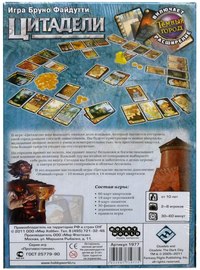 д.
д.
Этот процесс продолжается до тех пор, пока каждый игрок не выберет одну карту из колоды персонажей. После того, как последний игрок сделал выбор, единственная оставшаяся невыбранная карта кладется лицевой стороной вниз в центр стола.
Шаг третий: Ходы игроков
После того, как все игроки выбрали карту персонажа, игрок, у которого есть Корона, теперь называет имя каждого персонажа по одному в порядке числового ранга. Таким образом, он сначала вызывает «Убийцу» (№ 1), затем «Вора» (№ 2) и т. д. Если ни один игрок не показывает этого персонажа при вызове, просто вызывает следующего персонажа в порядке ранга.
Когда будет названо имя карты вашего персонажа, вы должны открыть карту своего персонажа, положить ее лицом вверх перед собой и начать свой ход. Когда ваш ход окончен, игрок с Короной называет имя следующей карты персонажа. Таким образом, игра переходит к каждому персонажу в порядке их ранга, давая всем игрокам по одному ходу (если, конечно, они не убиты Убийцей).
В свой ход вы должны сначала совершить действие, после чего вы можете построить карту района.
Выполнить действие
В начале вашего хода вы должны выполнить одно из следующих действий:
- Взять два золота из банка или
- Возьмите две карты районов из колоды районов, выберите одну карту и положите ее себе в руку, а другую карту положите под низ колоды районов.
Построить карту района
После того, как вы совершили действие, вы можете построить одну карту района в своем городе (то есть положить ее из руки на стол перед собой). Для этого вы должны заплатить банку стоимость района золотом. Вы можете не строить карту района, если хотите.
Стоимость постройки карты района в золоте равна количеству золотых монет, напечатанному в верхней левой части карты.
Вы не можете построить район так, чтобы у вас было два одинаковых района (две карты «Замок», две карты «Рынок» и т. д.). в вашем городе.

Персонажи и их особые способности
У каждого персонажа есть особая способность, также называемая силой. Вы можете использовать силу своего персонажа один раз за свой ход. Особая сила каждого персонажа кратко описана на соответствующей карте и подробно описана в конце этих правил. Обязательно ознакомьтесь с подробными способностями, прежде чем играть в свою первую игру.
Шаг четвертый: Конец раунда
После того, как все персонажи были вызваны, каждый игрок возвращает свою карту персонажа в колоду персонажей, которая перемешивается, и начинается новый раунд.
Конец игры
Когда игрок строит свой восьмой район, игра заканчивается после завершения текущего раунда. Используйте этот процесс подсчета очков, чтобы определить, сколько очков получает каждый игрок:
В конце игры игрок получает количество очков, равное общей сумме золотых затрат всех карт районов в его городе.
Если у игрока есть хотя бы один район каждого из пяти цветов, он получает три очка.

Если игрок первым построил восемь районов, он получает четыре очка.
Все остальные игроки, построившие восемь кварталов в конце игры, получают по два очка.
Победителем игры становится игрок, набравший наибольшее количество очков. В случае ничьей сравните общее количество очков, полученных только на шаге 1 описанного выше процесса подсчета очков. Если по-прежнему ничья, побеждает игрок с наибольшим количеством золота.
Примечание. Игроки могут построить более восьми районов в своем городе, если у них есть на это средства.
Продолжить чтение
Цитадели | Свод правил Вики | Фэндом
в: Специализированные карточные игры с колодой, Fantasy Flight
Содержание
- 1 Введение
- 2 компонента
- 2.1 Районные карты
- 2.2 Карточки персонажей
- 2.3 Справочные карты
- 2.4 Золотые жетоны
- 2.5 Деревянный маркер короны
- 3 Настройка базовой игры
- 4 Игра в игру
- 4.
 1 Шаг первый: удаление символов
1 Шаг первый: удаление символов - 4.2 Шаг второй: выберите персонажей
- 4.3 Шаг третий: ход игрока
- 4.4 Шаг четвертый: конец раунда
- 4.
- 5 Конец игры
- 6 Другие правила
- 6.1 Игры для двух или трех игроков
- 6.1.1 Игра для двух игроков
- 6.1.2 Игра для трех игроков
- 6.2 Игра для семи игроков
- 6.3 Укороченная игра
- 6.1 Игры для двух или трех игроков
- 7 бонусных карт
- 7.1 Бонусные персонажи
- 7.2 Бонусные районы
- 8 карт районов
- 8.1 Колокольня
- 8.2 Обсерватория и библиотека
- 8.3 Карьер
- 8.4 Кладбище
- 9 персонажей
Введение[]
В Citadels каждый игрок управляет городом и стремится увеличить его процветание, строя новые городские районы. Игра заканчивается после того, как один из игроков построил свой восьмой район, после чего победитель определяется по тому, сколько очков стоит его завершенный город.
Однако построить самый впечатляющий город — непростая задача. Только оказывая влияние на дворян, торговцев и других могущественных персонажей королевства, вы добьетесь успеха.
Компоненты[]
- 18 карт персонажей
- 80 районных карточек
- 8 справочных карт
- 30 жетонов золота
- 1 деревянный маркер в виде короны
- Эта книга правил
Карты районов[]
Эти карты представляют различные районы, которые вы можете добавить в свой город. Каждая карта района имеет стоимость, представленную количеством золотых монет вдоль левого края карты. Чтобы ввести карту района в игру, вы должны заплатить ее стоимость золотом.
Каждая карта района также имеет цветной кружок в левом нижнем углу, указывающий на тип района:
Типы районов и их цвет
| Цвет | Тип |
|---|---|
| Желтый | Благородный (Королевский доход) |
| Синий | Религия (Доход епископа) |
| Зеленый | Торговля (доход торговца) |
| красный | Военные (доход военачальника) |
| Фиолетовый | Special (особые преимущества описаны на самой карте) |
Четырнадцать фиолетовых карт районов являются бонусными картами , отмеченными белой звездой.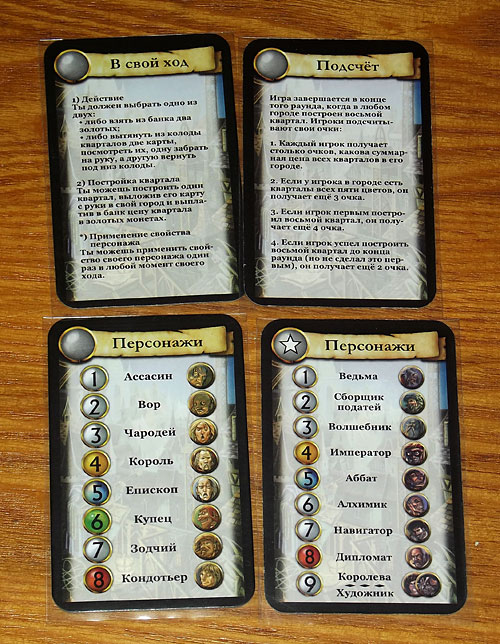 Прежде чем играть в свою первую игру, удалите эти карты. Правила использования бонусных карт районов приведены позже.
Прежде чем играть в свою первую игру, удалите эти карты. Правила использования бонусных карт районов приведены позже.
Карты персонажей[]
Эти карты представляют персонажей, на которых игроки стремятся повлиять в каждом игровом раунде. В Citadels есть восемь основных персонажей, но в последнем издании вы также найдете 10 дополнительных бонусных карт персонажей, отмеченных белой звездой. Эти бонусные персонажи не используются в основной игре. Прежде чем играть в свою первую игру, удалите эти карты. Позже мы научим вас их использовать.
В дополнение к особой способности, каждая карта персонажа имеет номер ранга от одного до девяти. Этот номер напечатан в верхней левой части карты.
Справочные карты[]
Каждый игрок берет одну из этих карт в начале игры. Они полезны для игрового процесса, особенно во время первых нескольких игр.
Золотые жетоны[]
Представляют собой золото, необходимое для создания карт районов. Разместите их на столе в центральном «банке» в начале игры.
Маркер деревянной короны[]
Игрок с короной первым выбирает карту персонажа в следующем раунде. Корона меняет владельца всякий раз, когда другой игрок выбирает персонажа-короля.
Настройка базовой игры[]
Чтобы подготовить Цитадели к игре, выполните следующие действия:
- Удалите бонусного персонажа и карты районов (отмечены белой звездой).
- Перемешайте восемь оставшихся карт персонажей в одну колоду. это называется Колода персонажей .
- Смешайте оставшиеся карты районов в одну колоду. Это называется District Deck .
- Затем каждому игроку раздается по четыре случайные карты районов из колоды районов.
- Каждый игрок получает из банка два золота.
- Самый старший игрок получает Корону.
Игра в игру[]
Игра в 4-6 игроков описана ниже. Если вы играете с 2, 3 или 7 игроками, ознакомьтесь со специальными правилами. Citadels играется в серии из патронов ; каждый раунд имеет четыре шага .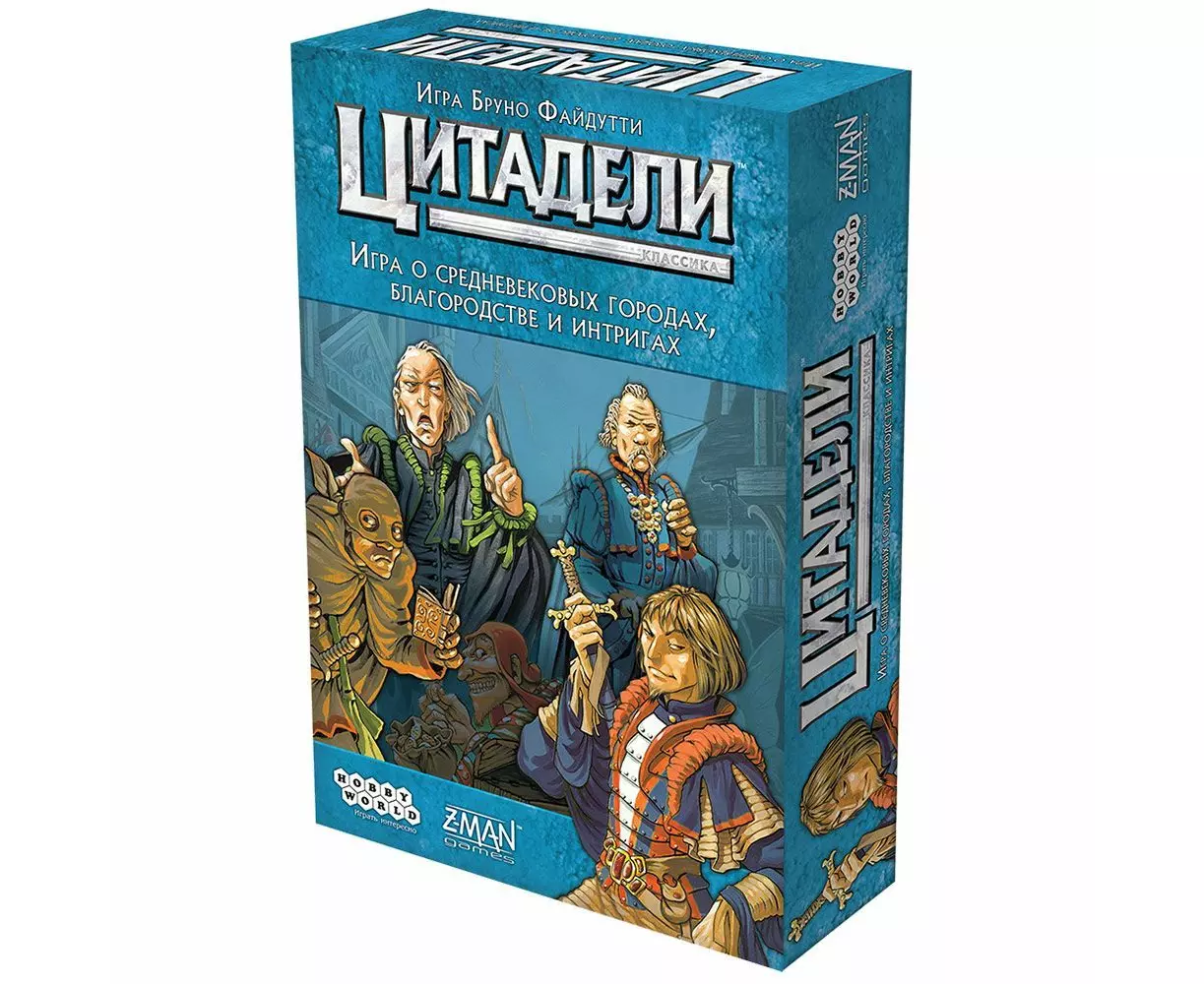
Шаг первый: удаление персонажей[]
Сначала возьмите одну случайную карту из колоды персонажей и положите ее лицевой стороной вниз в центр стола, не глядя на нее. эта карта не будет использоваться в этом раунде.
Затем возьмите второй набор карт из Колоды Персонажей и положите их лицом вверх в середину стола (количество таких карт лицом вверх зависит от количества игроков, см. следующую таблицу). Эти открытые карты не будут использоваться в этом раунде.
Специальное правило : Если вы вытягиваете Короля лицом вверх, немедленно замените его другой случайной картой из Колоды Персонажей, а затем замешайте Короля обратно в Колоду Персонажей.
Открытые карты для 4-7 игроков
| Количество игроков | Количество открытых карт |
|---|---|
| 4 | 2 |
| 5 | 1 |
| 6-7 | 0 |
Шаг второй: выберите персонажей[]
Игрок, у которого в данный момент есть Корона, теперь берет колоду персонажей, смотрит на карты и тайно выбирает персонажа из доступных.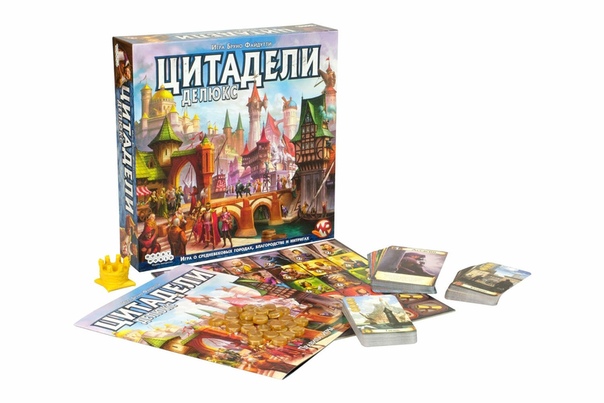 Затем он передает оставшиеся карты персонажей игроку слева от него, который также тайно выбирает карту и передает оставшиеся карты слева и т. д. Этот процесс продолжается до тех пор, пока каждый игрок не выберет одну карту из колоды персонажей. После того, как последний игрок сделал выбор, единственная оставшаяся невыбранная карта кладется лицевой стороной вниз в центр стола. (Что это значит? Вы продолжаете тянуть карты, пока они не закончатся? Как получить одну оставшуюся карту?)
Затем он передает оставшиеся карты персонажей игроку слева от него, который также тайно выбирает карту и передает оставшиеся карты слева и т. д. Этот процесс продолжается до тех пор, пока каждый игрок не выберет одну карту из колоды персонажей. После того, как последний игрок сделал выбор, единственная оставшаяся невыбранная карта кладется лицевой стороной вниз в центр стола. (Что это значит? Вы продолжаете тянуть карты, пока они не закончатся? Как получить одну оставшуюся карту?)
Шаг третий: Ходы игроков[]
После того, как все игроки выбрали карту персонажа, игрок, у которого есть Корона, теперь называет имя каждого персонажа по одному в порядке числового ранга. Таким образом, он сначала вызывает «Убийцу» (№ 1), затем «Вора» (№ 2) и т. д. Если ни один игрок не показывает этого персонажа при вызове, просто вызывает следующего персонажа в порядке ранга.
Когда будет названо имя карты вашего персонажа, вы должны показать карту своего персонажа, положить ее перед собой лицом вверх и начать свой ход. Когда ваш ход окончен, игрок с Короной называет имя следующей карты персонажа. Таким образом, игра переходит к каждому персонажу в порядке их ранга, давая всем игрокам по одному ходу (если, конечно, они не убиты Убийцей).
Когда ваш ход окончен, игрок с Короной называет имя следующей карты персонажа. Таким образом, игра переходит к каждому персонажу в порядке их ранга, давая всем игрокам по одному ходу (если, конечно, они не убиты Убийцей).
В вашу очередь
В свой ход вы должны совершить действие, после которого можете построить карту района.
1 ) Выполнить действие: В начале своего хода вы должны выполнить одно из следующего:
- Взять два золота из банка или
- Возьмите две карты районов из колоды районов, выберите одну карту и положите ее себе в руку, а другую карту положите под низ колоды районов.
2 ) Построить карту района: : После того, как вы совершили действие, вы можете построить одну карту района в своем городе (то есть положить ее из руки на стол перед вами). Для этого вы должны заплатить банку стоимость района золотом. Вы можете не строить карту района, если хотите.
Стоимость постройки карты района в золоте равна количеству золотых монет, напечатанному в верхней левой части карты.


 They should be placed on the table in a
central “Bank” at the beginning of the game.
3
The Wooden Crown counter
The player who has the Crown is the first player to
choose a character card during the next
round. The Crown switches owners
whenever another player uses the ability of
the “King” character.
SETTING UP THE BASIC GAME
To prepare Citadels for play, follow these steps:
1. Remove the bonus character and district cards
(marked by a white star).
2. Shuffle the eight remaining character cards
together into one deck. This is called the Character
Deck.
3. Shuffle the remaining district cards together into
one deck. This is called the District Deck.
4. Each player is then dealt four random district
cards from the District Deck.
5. Each player receives two gold from the bank.
6. The oldest player receives the Crown.
PLAYING THE GAME
Playing the game with 4-6 players is
described below.
They should be placed on the table in a
central “Bank” at the beginning of the game.
3
The Wooden Crown counter
The player who has the Crown is the first player to
choose a character card during the next
round. The Crown switches owners
whenever another player uses the ability of
the “King” character.
SETTING UP THE BASIC GAME
To prepare Citadels for play, follow these steps:
1. Remove the bonus character and district cards
(marked by a white star).
2. Shuffle the eight remaining character cards
together into one deck. This is called the Character
Deck.
3. Shuffle the remaining district cards together into
one deck. This is called the District Deck.
4. Each player is then dealt four random district
cards from the District Deck.
5. Each player receives two gold from the bank.
6. The oldest player receives the Crown.
PLAYING THE GAME
Playing the game with 4-6 players is
described below.
 He then
passes the remaining character cards to the player on
his left, who also secretly chooses a card and passes
the remaining cards to the left, etc. This continues
until each player has chosen one card from the
Character Deck. After the last player has chosen, the
single remaining unchosen card is placed facedown
in the center of the table.
Step Three: Player Turns
Once all players have chosen a character card, the
player who has the Crown now calls out the name of
each character one-at-a-time in the order of
numerical rank. In this way, he will first call out the
“Assassin” (#1), then the “Thief” (#2), etc. If no
4 2
5 1
6-7 0
Number
of Players
Number of
faceup cards
FACE UP CARDS FOR 4-7 PLAYERS
5
player reveals that a character when called, simply
proceed to call out the next character in rank order.
When the name of your character card is called,
you must reveal your character card, place it faceup
in front of you, and take your turn.
He then
passes the remaining character cards to the player on
his left, who also secretly chooses a card and passes
the remaining cards to the left, etc. This continues
until each player has chosen one card from the
Character Deck. After the last player has chosen, the
single remaining unchosen card is placed facedown
in the center of the table.
Step Three: Player Turns
Once all players have chosen a character card, the
player who has the Crown now calls out the name of
each character one-at-a-time in the order of
numerical rank. In this way, he will first call out the
“Assassin” (#1), then the “Thief” (#2), etc. If no
4 2
5 1
6-7 0
Number
of Players
Number of
faceup cards
FACE UP CARDS FOR 4-7 PLAYERS
5
player reveals that a character when called, simply
proceed to call out the next character in rank order.
When the name of your character card is called,
you must reveal your character card, place it faceup
in front of you, and take your turn.

 At the end
of the game, each player receives points for all of
the following:
• A player receives a number of points equal to the
total combined gold cost of all the district cards in
his city at the end of the game
• If a player has at least one district in each of the
five colors, he receives 3 points
• If a player was the first player to build
eight districts, he receives 4 points
• All other players that have
managed to build eight districts at the
end of the game receive 2 points
The winner of the game is the
player with the most points.
7
OTHER RULES
Two- or Three-Player Games
In a two- or three-player game, all players play
with two characters each. The game is played
normally, except that each player will have two turns
during each round (one turn for each character).
Players do not have to separate their gold or their
districts between their characters, as they still only
have one city.
At the end
of the game, each player receives points for all of
the following:
• A player receives a number of points equal to the
total combined gold cost of all the district cards in
his city at the end of the game
• If a player has at least one district in each of the
five colors, he receives 3 points
• If a player was the first player to build
eight districts, he receives 4 points
• All other players that have
managed to build eight districts at the
end of the game receive 2 points
The winner of the game is the
player with the most points.
7
OTHER RULES
Two- or Three-Player Games
In a two- or three-player game, all players play
with two characters each. The game is played
normally, except that each player will have two turns
during each round (one turn for each character).
Players do not have to separate their gold or their
districts between their characters, as they still only
have one city.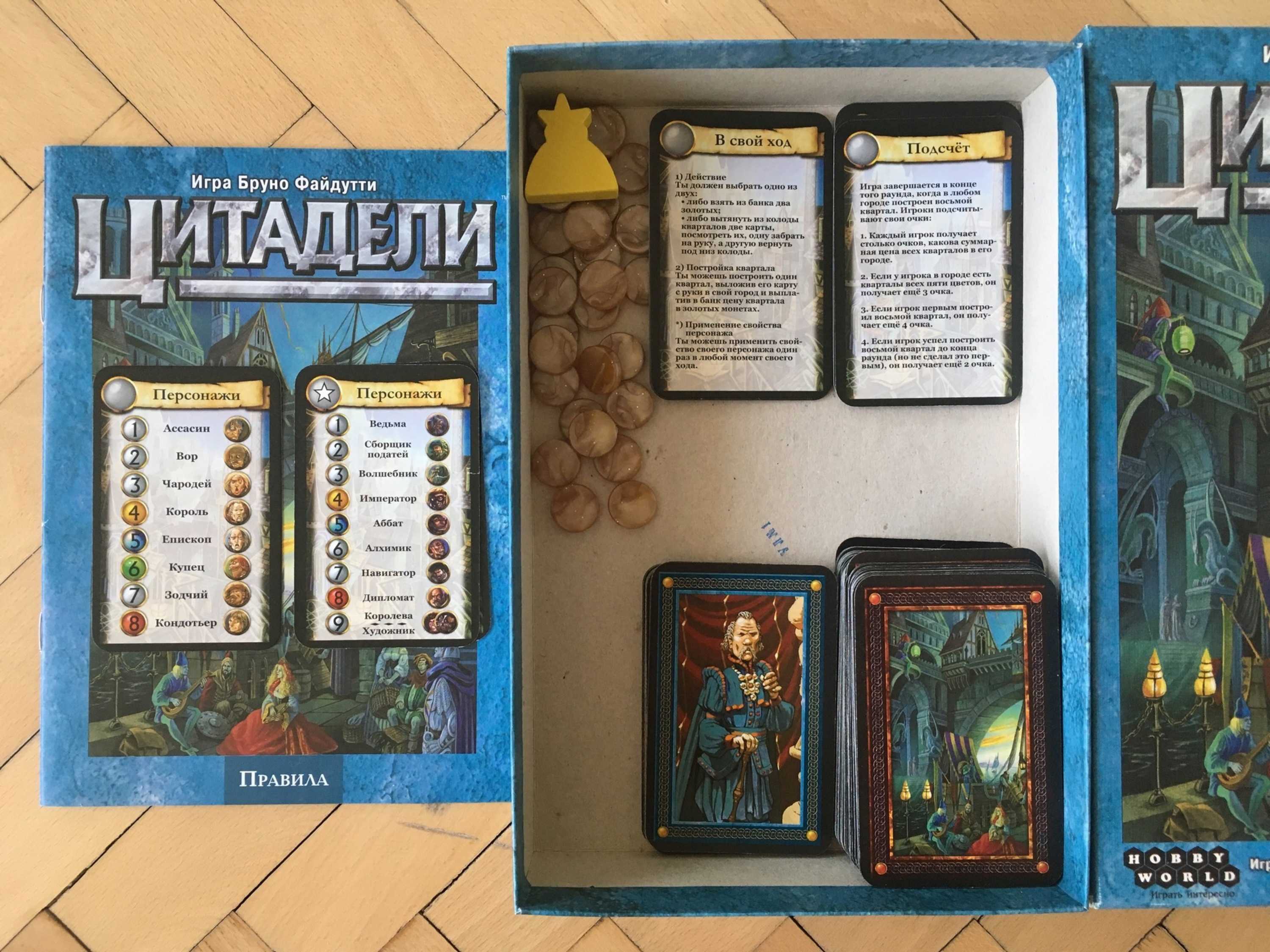
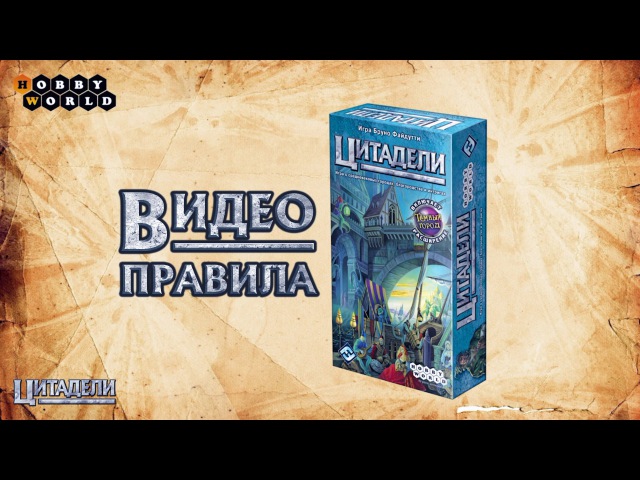 He then passes the remaining two cards to
Player B.
8
4. Player B takes one of the remaining cards, placing
the last card facedown in the center of the table.
The Three-Player Game
The player with the Crown takes the Character
Deck, places a random card facedown in the middle
of the table, and then secretly chooses a character
for himself.
He then passes the remaining character cards to
the player on his left, who also chooses a card, and
then passes the remaining cards to the left, etc.
This continues until each player has chosen two
cards from the Character Deck. The last player will
select one of the two remaining cards, and place the
last card facedown in the center of the table.
The Seven-Player Game
A seven player game of Citadels plays much like
the normal game, with one exception:
During the “Choose Characters” step of a sevenplayer
game, when the seventh player is handed the
last character card from the sixth player, he secretly
looks at the facedown card on the table.
He then passes the remaining two cards to
Player B.
8
4. Player B takes one of the remaining cards, placing
the last card facedown in the center of the table.
The Three-Player Game
The player with the Crown takes the Character
Deck, places a random card facedown in the middle
of the table, and then secretly chooses a character
for himself.
He then passes the remaining character cards to
the player on his left, who also chooses a card, and
then passes the remaining cards to the left, etc.
This continues until each player has chosen two
cards from the Character Deck. The last player will
select one of the two remaining cards, and place the
last card facedown in the center of the table.
The Seven-Player Game
A seven player game of Citadels plays much like
the normal game, with one exception:
During the “Choose Characters” step of a sevenplayer
game, when the seventh player is handed the
last character card from the sixth player, he secretly
looks at the facedown card on the table.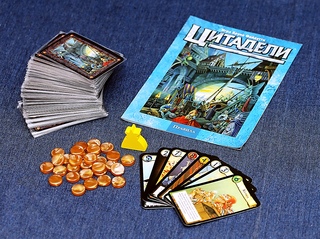
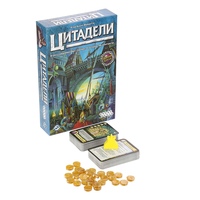 When using a rank 9 character
card, you can play Citadels with
eight players. When playing
with eight players, simply
use the rule for the sevenplayer
game in which the
last player may chose
between the remaining
character and the
facedown character in the
middle of the table.
4 3
5 2
6 1
7 0
Number
of Players
Number of
faceup cards
FACEUP CARDS FOR 4-7 PLAYERS
WHEN PLAYING WITH 9 CHARACTERS
10
The Bonus District Cards
Before the game begins, players may agree to add
2-3 additional purple district cards to the District Deck
from the 14 available bonus district cards. If players
wish to use more than 2-3 of the bonus district cards,
they should remove one existing purple district card
for each additional bonus district card used.
Shorter Game
If players agree, the game can be made shorter by
playing to seven districts instead of eight.
When using a rank 9 character
card, you can play Citadels with
eight players. When playing
with eight players, simply
use the rule for the sevenplayer
game in which the
last player may chose
between the remaining
character and the
facedown character in the
middle of the table.
4 3
5 2
6 1
7 0
Number
of Players
Number of
faceup cards
FACEUP CARDS FOR 4-7 PLAYERS
WHEN PLAYING WITH 9 CHARACTERS
10
The Bonus District Cards
Before the game begins, players may agree to add
2-3 additional purple district cards to the District Deck
from the 14 available bonus district cards. If players
wish to use more than 2-3 of the bonus district cards,
they should remove one existing purple district card
for each additional bonus district card used.
Shorter Game
If players agree, the game can be made shorter by
playing to seven districts instead of eight.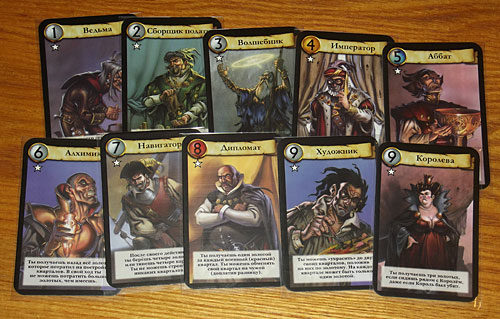 THE CHARACTERS
Every character in Citadels has a unique special
power. You may (it is not mandatory to use the
special power) use your character’s power once at
any point during your turn. Each character’s power
is summarized on its card, and detailed below:
Note: Characters who receive income for certain
types of districts in their cities (the King, Emperor,
Bishop, Abbot, Merchant, Diplomat, and Warlord)
may use their power to receive this gold at any point
in their turn. Thus you may choose to receive your
income either before building new districts (if you
need the gold in order to
build the districts), or
after building new
districts (to gain
income from the
newly built district).
You cannot, however,
do both.
11
12
1) Assassin
Announce the title of another character
that you wish to murder. The player who has
the murdered character must say nothing, and
must remain silent when the murdered
character is called upon to take his turn.
THE CHARACTERS
Every character in Citadels has a unique special
power. You may (it is not mandatory to use the
special power) use your character’s power once at
any point during your turn. Each character’s power
is summarized on its card, and detailed below:
Note: Characters who receive income for certain
types of districts in their cities (the King, Emperor,
Bishop, Abbot, Merchant, Diplomat, and Warlord)
may use their power to receive this gold at any point
in their turn. Thus you may choose to receive your
income either before building new districts (if you
need the gold in order to
build the districts), or
after building new
districts (to gain
income from the
newly built district).
You cannot, however,
do both.
11
12
1) Assassin
Announce the title of another character
that you wish to murder. The player who has
the murdered character must say nothing, and
must remain silent when the murdered
character is called upon to take his turn. The
murdered character misses his entire turn.
2) Thief
Announce the title of a character from
whom you wish to steal. When the player
who has that character is called upon to take
his turn, you first take all of his gold. You
may not steal from the Assassin or the
Assassin’s target.
3) Magician
At any time during your turn, you may
do one of the following two things:
• Exchange your entire hand of cards (not the
cards in your city) with the hand of another
player (this applies even if you have no cards
in your hand, in which case you simply take
the other player’s cards).
• Place any number of cards from your hand
facedown at the bottom of the District Deck,
then draw an equal number of cards from the
top of the District Deck.
13
4) King
You receive one gold for each noble
(yellow) district in your city.
When the King is called, you immediately
receive the Crown.
The
murdered character misses his entire turn.
2) Thief
Announce the title of a character from
whom you wish to steal. When the player
who has that character is called upon to take
his turn, you first take all of his gold. You
may not steal from the Assassin or the
Assassin’s target.
3) Magician
At any time during your turn, you may
do one of the following two things:
• Exchange your entire hand of cards (not the
cards in your city) with the hand of another
player (this applies even if you have no cards
in your hand, in which case you simply take
the other player’s cards).
• Place any number of cards from your hand
facedown at the bottom of the District Deck,
then draw an equal number of cards from the
top of the District Deck.
13
4) King
You receive one gold for each noble
(yellow) district in your city.
When the King is called, you immediately
receive the Crown. You will now call the
characters, and you will be the first player to
choose your character during the next round.
If there is no King during the next round,
you keep the Crown. If you are murdered,
you skip your turn like any other character.
Nevertheless, after the last player has played
his turn, when it becomes known that you
had the murdered King’s character card, you
take the Crown (as the king's heir).
5) Bishop
You receive one gold for each religious
(blue) district in your city. Your districts
may not be destroyed by the Warlord.
6) Merchant
You receive one gold for each trade
(green) district in your city. After you take
an action, you receive one additional gold.
14
7) Architect
After you take an action, you draw two
additional district cards and put both in your
hand. You may build up to three districts
during your turn.
8) Warlord
You receive one gold for each military
(red) district in your city.
You will now call the
characters, and you will be the first player to
choose your character during the next round.
If there is no King during the next round,
you keep the Crown. If you are murdered,
you skip your turn like any other character.
Nevertheless, after the last player has played
his turn, when it becomes known that you
had the murdered King’s character card, you
take the Crown (as the king's heir).
5) Bishop
You receive one gold for each religious
(blue) district in your city. Your districts
may not be destroyed by the Warlord.
6) Merchant
You receive one gold for each trade
(green) district in your city. After you take
an action, you receive one additional gold.
14
7) Architect
After you take an action, you draw two
additional district cards and put both in your
hand. You may build up to three districts
during your turn.
8) Warlord
You receive one gold for each military
(red) district in your city. At the end of your
turn, you may destroy one district of your
choice by paying a number of gold equal to
one less than the cost of the district. Thus,
you may destroy a cost 1 district for free, a
cost 2 district for 1 gold, or a cost 5 district
for 4 gold, etc. You may destroy one of your
own districts. You may not, however, destroy
a district in a city that is already completed
by having eight districts.
Credits
Design: Bruno Faidutti
Illustration: Julien Delval, Florence Magnin, Jean-Louis Mourier, Jesper
Ejsing, Bjarne Hansen
Graphic Design: Cyrille Daujean, Brian Schomburg, Scott Nicely, Richard
Spicer, Christian T. Petersen
Editing & Rules: Darrell Hardy, Christian T. Petersen
Citadels and Citadels: Dark City Expansion are a trademark of Fantasy
Flight Publishing, Inc. Copyright ©2006 Fantasy Flight Publishing, Inc. All
rights reserved. No part of this product may be reproduced without specific
permission from the publisher.
At the end of your
turn, you may destroy one district of your
choice by paying a number of gold equal to
one less than the cost of the district. Thus,
you may destroy a cost 1 district for free, a
cost 2 district for 1 gold, or a cost 5 district
for 4 gold, etc. You may destroy one of your
own districts. You may not, however, destroy
a district in a city that is already completed
by having eight districts.
Credits
Design: Bruno Faidutti
Illustration: Julien Delval, Florence Magnin, Jean-Louis Mourier, Jesper
Ejsing, Bjarne Hansen
Graphic Design: Cyrille Daujean, Brian Schomburg, Scott Nicely, Richard
Spicer, Christian T. Petersen
Editing & Rules: Darrell Hardy, Christian T. Petersen
Citadels and Citadels: Dark City Expansion are a trademark of Fantasy
Flight Publishing, Inc. Copyright ©2006 Fantasy Flight Publishing, Inc. All
rights reserved. No part of this product may be reproduced without specific
permission from the publisher.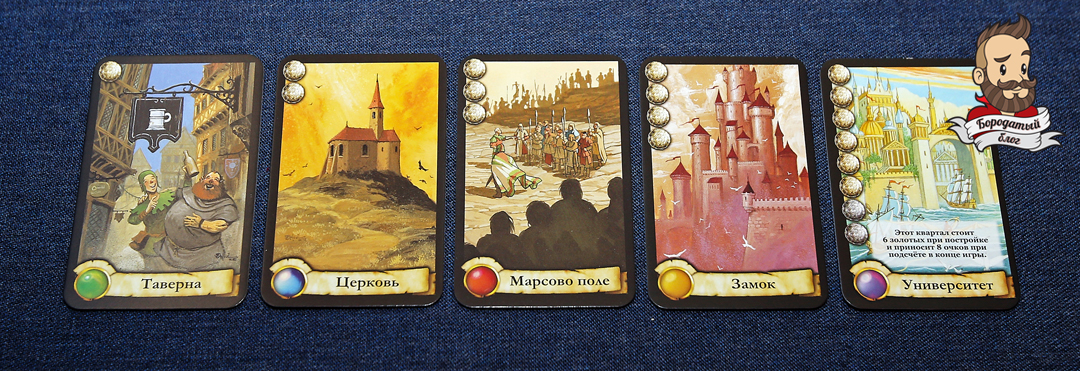 15
BONUS CHARACTERS
1) Witch
After you take an action, announce the
title of another character that you wish to
bewitch, then immediately end your turn.
When the bewitched character is called upon,
its player must show his character card, take
an action, and then immediately end his turn.
You now resume this player’s turn as if you
were playing the bewitched character, using
all that character’s powers (including the gold
bonus of the Merchant or the two card bonus
of the Architect) in your city.
If the King is bewitched, the King player still
receives the Crown counter. If the bewitched
character is not in play, you do not resume
your turn. The Thief cannot steal from the
Witch or the bewitched character.
2) Tax Collector
After another player has built one or
more districts in his city, that player must, at
the end of his turn, give you one gold (if he
has any gold left).
15
BONUS CHARACTERS
1) Witch
After you take an action, announce the
title of another character that you wish to
bewitch, then immediately end your turn.
When the bewitched character is called upon,
its player must show his character card, take
an action, and then immediately end his turn.
You now resume this player’s turn as if you
were playing the bewitched character, using
all that character’s powers (including the gold
bonus of the Merchant or the two card bonus
of the Architect) in your city.
If the King is bewitched, the King player still
receives the Crown counter. If the bewitched
character is not in play, you do not resume
your turn. The Thief cannot steal from the
Witch or the bewitched character.
2) Tax Collector
After another player has built one or
more districts in his city, that player must, at
the end of his turn, give you one gold (if he
has any gold left). If the Assassin or the
Witch has already built a district card, their
players must pay you one gold as you reveal
that you have the Tax Collector.
16
3) Wizard
You may look at another player’s hand
of cards and take one card. You may then
either put this card into your hand, or pay to
build it in your city. If you build it in your
city, it does not count towards the one district
building limit, which means you can build
another district as well. During this turn, you
may build district cards identical to another
district already in your city.
4) Emperor
You receive one gold for each noble
(yellow) district in your city. When the
Emperor is called, you immediately must
take the Crown from the player who has it
and give it to a different player (but not
yourself). The player who receives the Crown
must give you either one gold or one district
card from his hand. If the player has neither a
gold nor a card, he does not have to give you
anything.
If the Assassin or the
Witch has already built a district card, their
players must pay you one gold as you reveal
that you have the Tax Collector.
16
3) Wizard
You may look at another player’s hand
of cards and take one card. You may then
either put this card into your hand, or pay to
build it in your city. If you build it in your
city, it does not count towards the one district
building limit, which means you can build
another district as well. During this turn, you
may build district cards identical to another
district already in your city.
4) Emperor
You receive one gold for each noble
(yellow) district in your city. When the
Emperor is called, you immediately must
take the Crown from the player who has it
and give it to a different player (but not
yourself). The player who receives the Crown
must give you either one gold or one district
card from his hand. If the player has neither a
gold nor a card, he does not have to give you
anything.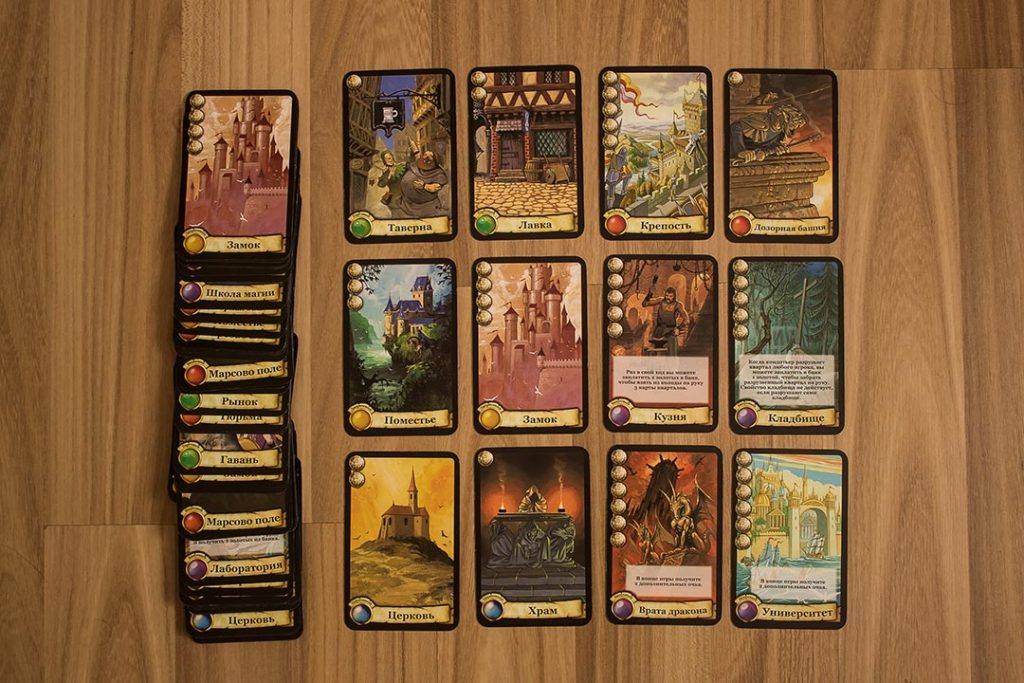 (Note that, like the King, the
Emperor may not be in the faceup discarded
character cards.)
5) Abbot
You receive one gold for each religious
(blue) district in your city. The player who
has the most gold must give you one gold. If
there is a tie for the player with the most
gold, or if you have the most gold, then you
do not receive the gold.
17
6) Alchemist
At the end of your turn, you receive
back all the gold you spent to build district
cards this turn, but not the gold you spent for
other reasons (paying the Tax Collector, for
example). You cannot spend more gold than
you have during your turn.
7) Navigator
After taking your action, you may
either receive an additional four gold or
draw an additional four cards. You may not
build any district cards.
8) Diplomat
You receive one gold for each military
(red) district in your city. At the end of your
turn, you may take a district from another
player’s city in exchange for a district in your
city.
(Note that, like the King, the
Emperor may not be in the faceup discarded
character cards.)
5) Abbot
You receive one gold for each religious
(blue) district in your city. The player who
has the most gold must give you one gold. If
there is a tie for the player with the most
gold, or if you have the most gold, then you
do not receive the gold.
17
6) Alchemist
At the end of your turn, you receive
back all the gold you spent to build district
cards this turn, but not the gold you spent for
other reasons (paying the Tax Collector, for
example). You cannot spend more gold than
you have during your turn.
7) Navigator
After taking your action, you may
either receive an additional four gold or
draw an additional four cards. You may not
build any district cards.
8) Diplomat
You receive one gold for each military
(red) district in your city. At the end of your
turn, you may take a district from another
player’s city in exchange for a district in your
city. If the district you take has a higher cost
than the district you give, you must pay the
difference in gold to the player with whom
you make the exchange. (The Great Wall
affects this cost.) You may not take the Keep
district, or any districts in the Bishop’s city.
Note: If you are using the Diplomat in your
game, you must remove the Cemetery from
the deck, as it will not be used.
18
9) Queen
You receive three gold if you are sitting next to the King (or the Emperor). If the
King has been murdered, but was sitting beside you, you receive three gold when this
becomes known (that is, immediately after your turn). Note: Do not use the Queen in a
game with fewer than five players.
9) Artist
You may “beautify” one or two of your
districts by placing your gold on one or both
of them. The value of a beautified district
(and therefore the cost of destroying or
exchanging it) is increased by one. This also
increases the number of points you receive
for the district at the end of the game.
If the district you take has a higher cost
than the district you give, you must pay the
difference in gold to the player with whom
you make the exchange. (The Great Wall
affects this cost.) You may not take the Keep
district, or any districts in the Bishop’s city.
Note: If you are using the Diplomat in your
game, you must remove the Cemetery from
the deck, as it will not be used.
18
9) Queen
You receive three gold if you are sitting next to the King (or the Emperor). If the
King has been murdered, but was sitting beside you, you receive three gold when this
becomes known (that is, immediately after your turn). Note: Do not use the Queen in a
game with fewer than five players.
9) Artist
You may “beautify” one or two of your
districts by placing your gold on one or both
of them. The value of a beautified district
(and therefore the cost of destroying or
exchanging it) is increased by one. This also
increases the number of points you receive
for the district at the end of the game. There
can be only one gold piece on any one
district.
Bruno Faidutti’s Credits: Thanks to all who helped me test and tune this game,
specifically Nadine Bernard, Maud Bissonnet, Scarlett Bocchi, Frank Branham, David
Calvo, Brent & Maryann Carter, Fabienne Cazalis, Pitt Crandlemire, Isabelle Duvaux,
Thierry Fau, Philippe Keyaerts, David Kuznik, Serge Laget, Myriam Lemaire, Pierre
Lemoigne, Tristan Lhomme, Hervé Marly, Bernard Mendiburu, Hélène Michaux,
Steffan O'Sullivan, Philippe des Pallières, Jean-Marc Pauty, Pierre Rosenthal, Fred
Savart, Mik Svellov, and Irène Villa (I name only the most assiduous, constructive
players, and the prettiest girls). Thanks to all the attendants at my Vth Ludopathic
Gathering and at Alan Moon's Xth Gathering of friends. Thanks to Marcel-André
Casasola-Merkle, since one of the core systems of Citadels comes directly from his
game Verraeter. Thanks to Ron Magin, Bernd Brunnhofer, Dirk Geilenkeuser and
Volker Weitzel.
There
can be only one gold piece on any one
district.
Bruno Faidutti’s Credits: Thanks to all who helped me test and tune this game,
specifically Nadine Bernard, Maud Bissonnet, Scarlett Bocchi, Frank Branham, David
Calvo, Brent & Maryann Carter, Fabienne Cazalis, Pitt Crandlemire, Isabelle Duvaux,
Thierry Fau, Philippe Keyaerts, David Kuznik, Serge Laget, Myriam Lemaire, Pierre
Lemoigne, Tristan Lhomme, Hervé Marly, Bernard Mendiburu, Hélène Michaux,
Steffan O'Sullivan, Philippe des Pallières, Jean-Marc Pauty, Pierre Rosenthal, Fred
Savart, Mik Svellov, and Irène Villa (I name only the most assiduous, constructive
players, and the prettiest girls). Thanks to all the attendants at my Vth Ludopathic
Gathering and at Alan Moon's Xth Gathering of friends. Thanks to Marcel-André
Casasola-Merkle, since one of the core systems of Citadels comes directly from his
game Verraeter. Thanks to Ron Magin, Bernd Brunnhofer, Dirk Geilenkeuser and
Volker Weitzel.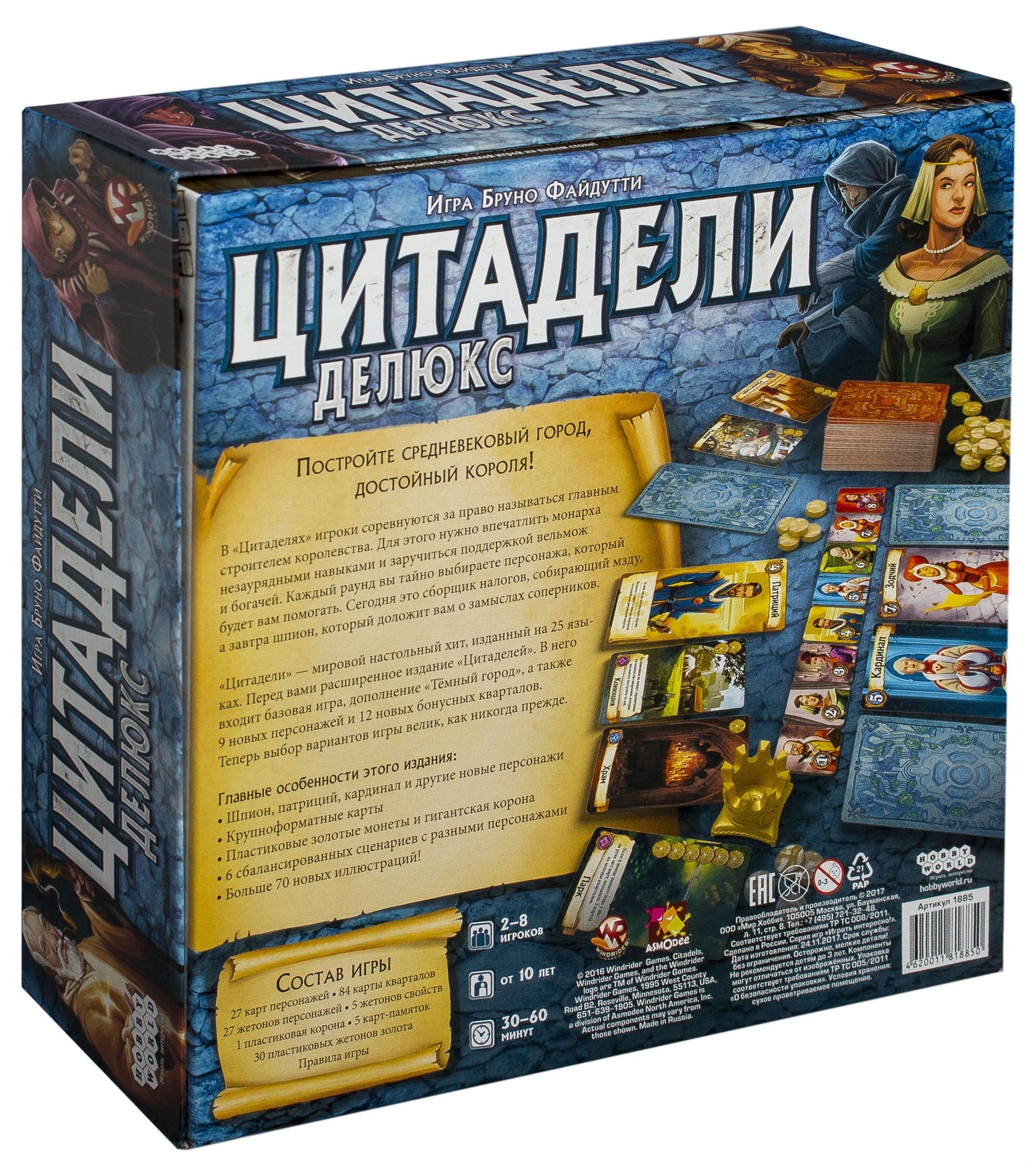 Thanks to all those who took part in the Ohne Furcht und Adel
character contest held by Hans im Glueck, and specifically to Ben Baldanza, Peter
Küsters, Gary Wong, Andrea Navratil, Christoph Heinzl, Stefanie Kethers, Alexander
Klein, Jonathan Degann, Holger Traczynski and Holger Baumgartner, whose ideas
inspired some of the new expansion characters. Thanks to Christian Petersen, of Fantasy
Flight Games, who was very patient with all the troubles with the English language
version rights. Most of all, thanks to Cyrille Daujean, whose help with designing,
testing and supporting this game was invaluable.
Thanks to all those who took part in the Ohne Furcht und Adel
character contest held by Hans im Glueck, and specifically to Ben Baldanza, Peter
Küsters, Gary Wong, Andrea Navratil, Christoph Heinzl, Stefanie Kethers, Alexander
Klein, Jonathan Degann, Holger Traczynski and Holger Baumgartner, whose ideas
inspired some of the new expansion characters. Thanks to Christian Petersen, of Fantasy
Flight Games, who was very patient with all the troubles with the English language
version rights. Most of all, thanks to Cyrille Daujean, whose help with designing,
testing and supporting this game was invaluable.



 Запрещается воздвигать два одинаковых квартала.
Запрещается воздвигать два одинаковых квартала.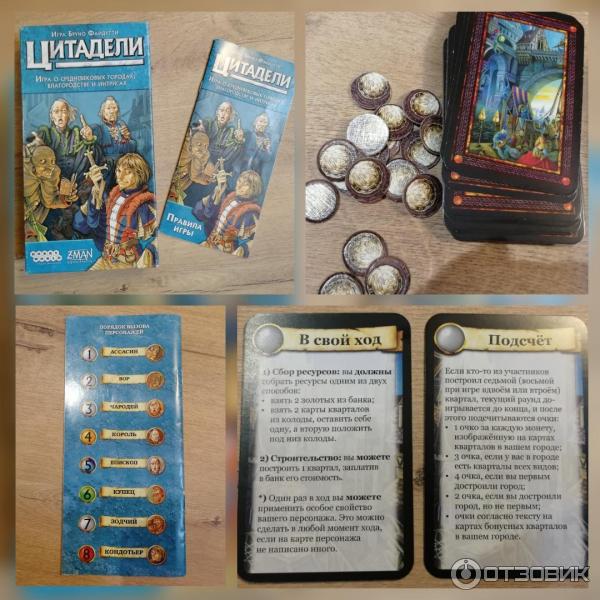

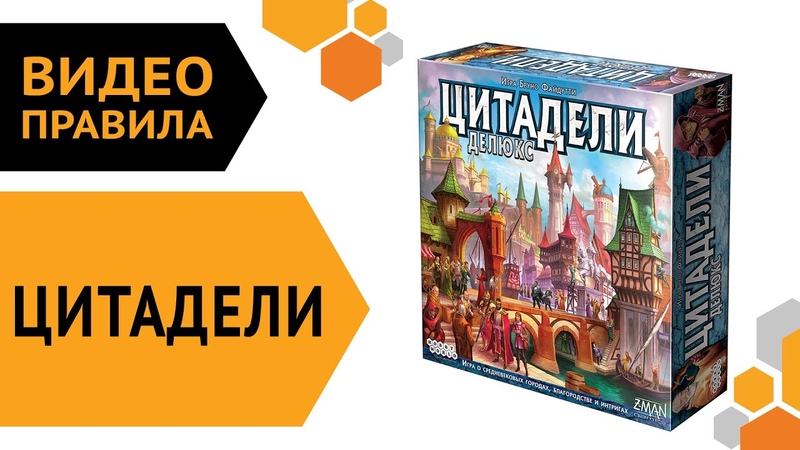 1 Шаг первый: удаление символов
1 Шаг первый: удаление символов